Deck 8: Cellular Reproduction
Question
Question
Question
Question
Question
Question
Question
Question
Question
Question
Question
Question
Question
Question
Question
Question
Question
Question
Question
Question
Question
Question
Question
Question
Question
Question
Question
Question
Question
Question
Question
Question
Question
Question
Question
Question
Question
Question
Question
Question
Question
Question
Question
Question
Question
Question
Question
Question
Question
Question
Question
Question
Question
Question
Question
Question
Question
Question
Question
Question
Question
Question
Question
Question
Question
Question
Question
Question
Question
Question
Question
Question
Question
Question
Question
Question
Question
Question

Unlock Deck
Sign up to unlock the cards in this deck!
Unlock Deck
Unlock Deck
1/78
Play
Full screen (f)
Deck 8: Cellular Reproduction
1
The structures labeled "d" in the following figure are called 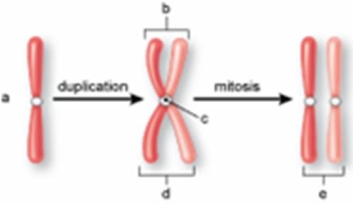
A) centromeres.
B) centrioles.
C) sister chromatids.
D) spindles.
E) non-sister chromatids.

A) centromeres.
B) centrioles.
C) sister chromatids.
D) spindles.
E) non-sister chromatids.
C
Explanation: The two halves of a chromosome the original DNA and the copy) are attached via the centromere. Each half is called a sister chromatid and they carry the same genetic information.
Explanation: The two halves of a chromosome the original DNA and the copy) are attached via the centromere. Each half is called a sister chromatid and they carry the same genetic information.
2
Refer to the figure below. Differentiated cells, such as nerve cells, would be in which of the following stages of the cell cycle? 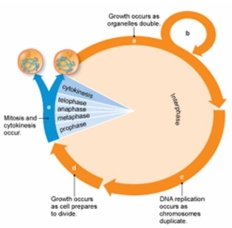
A) a
B) b
C) c
D) d
E) e

A) a
B) b
C) c
D) d
E) e
B
Explanation: Specialized or differentiated cells are in the G0 stage; they will not divide but remain in the G0 phase.
Explanation: Specialized or differentiated cells are in the G0 stage; they will not divide but remain in the G0 phase.
3
Which items in the following pairs are correctly matched?
A) G1 phase - DNA replication
B) G2 phase - preparation for meiosis
C) S phase - DNA replication
D) M phase - cell growth
E) G0 phases - cell growth
A) G1 phase - DNA replication
B) G2 phase - preparation for meiosis
C) S phase - DNA replication
D) M phase - cell growth
E) G0 phases - cell growth
C
Explanation: DNA synthesis occurs during the S phase of interphase.
Explanation: DNA synthesis occurs during the S phase of interphase.
4
While Jeff was looking under the microscope at cells in different stages of mitosis, he commented on the fact that many cells were in the same stage. If you were looking under the compound light microscope at an onion root tip, in what stage of the cell cycle would the majority of the cells be?
A) anaphase
B) metaphase
C) cytokinesis
D) interphase
E) prophase
A) anaphase
B) metaphase
C) cytokinesis
D) interphase
E) prophase

Unlock Deck
Unlock for access to all 78 flashcards in this deck.
Unlock Deck
k this deck
5
When during the cell cycle are chromosomes visible?
A) only during interphase
B) only when they are being copied
C) during mitosis
D) only during the G1 phase
E) Chromosomes are always visible.
A) only during interphase
B) only when they are being copied
C) during mitosis
D) only during the G1 phase
E) Chromosomes are always visible.

Unlock Deck
Unlock for access to all 78 flashcards in this deck.
Unlock Deck
k this deck
6
DNA and histones form bead-like globules known as
A) nucleotides.
B) the chromatin network.
C) centrosomes.
D) nucleosomes.
E) mesosomes.
A) nucleotides.
B) the chromatin network.
C) centrosomes.
D) nucleosomes.
E) mesosomes.

Unlock Deck
Unlock for access to all 78 flashcards in this deck.
Unlock Deck
k this deck
7
The G2 checkpoint prevents the cell cycle from continuing until
A) DNA is completely replicated.
B) damage to DNA can be repaired.
C) replicated DNA is separated.
D) organelles have been duplicated.
E) DNA is completely replicated and damage to DNA can be repaired.
A) DNA is completely replicated.
B) damage to DNA can be repaired.
C) replicated DNA is separated.
D) organelles have been duplicated.
E) DNA is completely replicated and damage to DNA can be repaired.

Unlock Deck
Unlock for access to all 78 flashcards in this deck.
Unlock Deck
k this deck
8
The figure below shows a cell in the mitotic stage of 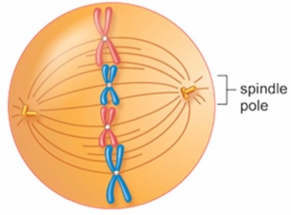
A) anaphase.
B) interphase.
C) metaphase.
D) prophase.
E) telophase.

A) anaphase.
B) interphase.
C) metaphase.
D) prophase.
E) telophase.

Unlock Deck
Unlock for access to all 78 flashcards in this deck.
Unlock Deck
k this deck
9
Which of the following represents the phases of mitosis in their proper sequence?
A) prophase, metaphase, anaphase, telophase
B) interphase, prophase, metaphase, telophase
C) anaphase, interphase, prophase, metaphase, telophase
D) prophase, metaphase, anaphase, telophase, cytokinesis
E) metaphase, interphase, cytokinesis, anaphase, telophase
A) prophase, metaphase, anaphase, telophase
B) interphase, prophase, metaphase, telophase
C) anaphase, interphase, prophase, metaphase, telophase
D) prophase, metaphase, anaphase, telophase, cytokinesis
E) metaphase, interphase, cytokinesis, anaphase, telophase

Unlock Deck
Unlock for access to all 78 flashcards in this deck.
Unlock Deck
k this deck
10
A mutation results in a cell that no longer produces a normal protein kinase for the M-phase checkpoint. Which of the following would likely be the immediate result of this mutation?
A) The cell would prematurely enter anaphase.
B) The cell would never leave metaphase.
C) The cell would never enter metaphase.
D) The cell would never enter prophase.
E) The cell would undergo normal mitosis, but fail to enter the next G1.
A) The cell would prematurely enter anaphase.
B) The cell would never leave metaphase.
C) The cell would never enter metaphase.
D) The cell would never enter prophase.
E) The cell would undergo normal mitosis, but fail to enter the next G1.

Unlock Deck
Unlock for access to all 78 flashcards in this deck.
Unlock Deck
k this deck
11
The structure labeled "c" in the following figure is called the 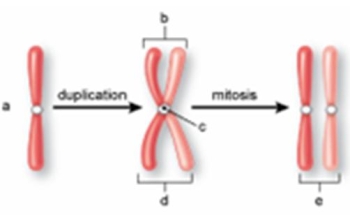
A) centromere.
B) centriole.
C) sister chromatid.
D) spindle.
E) non-sister chromatid.

A) centromere.
B) centriole.
C) sister chromatid.
D) spindle.
E) non-sister chromatid.

Unlock Deck
Unlock for access to all 78 flashcards in this deck.
Unlock Deck
k this deck
12
Nuclear division is represented in the figure below by the letter 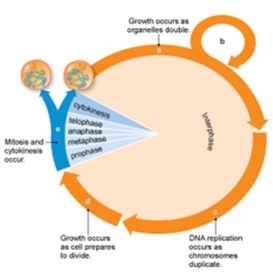
A) a.
B) b.
C) c.
D) d.
E) e.

A) a.
B) b.
C) c.
D) d.
E) e.

Unlock Deck
Unlock for access to all 78 flashcards in this deck.
Unlock Deck
k this deck
13
Which of the following organelles would be abundant and in close proximity to the cell plate in a plant cell undergoing cytokinesis?
A) centrioles
B) Golgi apparatus
C) rough endoplasmic reticulum
D) lysosomes
E) central vacuole
A) centrioles
B) Golgi apparatus
C) rough endoplasmic reticulum
D) lysosomes
E) central vacuole

Unlock Deck
Unlock for access to all 78 flashcards in this deck.
Unlock Deck
k this deck
14
Ben was looking at onion root tip cells under the microscope in biology class. He saw one cell that had two nuclei within it. What stage of the cell cycle was this cell in?
A) anaphase
B) interphase
C) metaphase
D) prophase
E) telophase/cytokinesis
A) anaphase
B) interphase
C) metaphase
D) prophase
E) telophase/cytokinesis

Unlock Deck
Unlock for access to all 78 flashcards in this deck.
Unlock Deck
k this deck
15
Which of the following statements is correct regarding the events of the cell cycle?
A) DNA is duplicated during the G1 and G2 phases.
B) DNA replicates during cytokinesis.
C) The M phase is usually the longest phase.
D) Interphase consists of G1, S, and G2.
E) The cell stops growing in G2 phase.
A) DNA is duplicated during the G1 and G2 phases.
B) DNA replicates during cytokinesis.
C) The M phase is usually the longest phase.
D) Interphase consists of G1, S, and G2.
E) The cell stops growing in G2 phase.

Unlock Deck
Unlock for access to all 78 flashcards in this deck.
Unlock Deck
k this deck
16
All of the following statements are true about mitosis except
A) the cells arising from the process are genetically alike.
B) the process of mitosis is followed by cytokinesis.
C) spindle fibers are involved in the movement of chromosomes.
D) both sexually and asexually reproducing organisms utilize the process of mitosis.
E) the cells arising from mitosis contain only half of the necessary genetic material.
A) the cells arising from the process are genetically alike.
B) the process of mitosis is followed by cytokinesis.
C) spindle fibers are involved in the movement of chromosomes.
D) both sexually and asexually reproducing organisms utilize the process of mitosis.
E) the cells arising from mitosis contain only half of the necessary genetic material.

Unlock Deck
Unlock for access to all 78 flashcards in this deck.
Unlock Deck
k this deck
17
The figure below shows a cell in the mitotic stage of 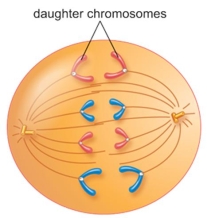
A) anaphase.
B) interphase.
C) metaphase.
D) prophase.
E) telophase.

A) anaphase.
B) interphase.
C) metaphase.
D) prophase.
E) telophase.

Unlock Deck
Unlock for access to all 78 flashcards in this deck.
Unlock Deck
k this deck
18
Susan was examining a cell under the microscope and noticed the formation of a cell plate in the midline of the cell and the formation of nuclei at opposite poles of the cell. The cell under examination was most likely an)
A) animal cell in the M phase of the cell cycle.
B) dividing bacterial cell.
C) plant cell undergoing cytokinesis.
D) animal cell undergoing cytokinesis.
E) plant cell in the anaphase stage.
A) animal cell in the M phase of the cell cycle.
B) dividing bacterial cell.
C) plant cell undergoing cytokinesis.
D) animal cell undergoing cytokinesis.
E) plant cell in the anaphase stage.

Unlock Deck
Unlock for access to all 78 flashcards in this deck.
Unlock Deck
k this deck
19
A cell is inhibited during the S phase of its cycle. It will not reproduce due to lack of
A) ATP availability.
B) centriole migration.
C) centromere formation.
D) DNA synthesis.
E) plasma membrane structure.
A) ATP availability.
B) centriole migration.
C) centromere formation.
D) DNA synthesis.
E) plasma membrane structure.

Unlock Deck
Unlock for access to all 78 flashcards in this deck.
Unlock Deck
k this deck
20
The figure below shows a cell in the mitotic stage of 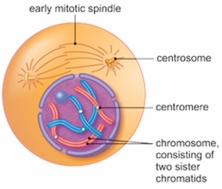
A) anaphase.
B) interphase.
C) metaphase.
D) prophase.
E) telophase.

A) anaphase.
B) interphase.
C) metaphase.
D) prophase.
E) telophase.

Unlock Deck
Unlock for access to all 78 flashcards in this deck.
Unlock Deck
k this deck
21
Cells grown in a petri dish tend to divide until they form a thin layer covering the bottom of the dish. Which of the following statements explains why this occurs?
A) The cells become deficient in cyclin.
B) The petri dish inhibits the cells'growth.
C) Cell division can be inhibited by the proximity of other cells of the same type, a process called contact inhibition.
D) Most cells grown in petri dishes have gone through apoptosis.
E) The cells have differentiated into more specialized cells.
A) The cells become deficient in cyclin.
B) The petri dish inhibits the cells'growth.
C) Cell division can be inhibited by the proximity of other cells of the same type, a process called contact inhibition.
D) Most cells grown in petri dishes have gone through apoptosis.
E) The cells have differentiated into more specialized cells.

Unlock Deck
Unlock for access to all 78 flashcards in this deck.
Unlock Deck
k this deck
22
All of the following occur during the latter stages of mitotic prophase except the
A) coiling of chromosomes.
B) division of centromeres.
C) formation of spindles.
D) synthesis of DNA.
E) degradation of the nuclear envelope.
A) coiling of chromosomes.
B) division of centromeres.
C) formation of spindles.
D) synthesis of DNA.
E) degradation of the nuclear envelope.

Unlock Deck
Unlock for access to all 78 flashcards in this deck.
Unlock Deck
k this deck
23
Proteins that are involved in the regulation of the cell cycle, and that show fluctuation in concentration during the cell cycle, are called
A) centromeres.
B) kinetochores.
C) centrioles.
D) proton pumps.
E) cyclins.
A) centromeres.
B) kinetochores.
C) centrioles.
D) proton pumps.
E) cyclins.

Unlock Deck
Unlock for access to all 78 flashcards in this deck.
Unlock Deck
k this deck
24
The drug chloral hydrate prevents elongation of microtubules by preventing the addition of new subunits to the growing end. During which stage of mitosis would chloral hydrate be most harmful?
A) prophase
B) metaphase
C) anaphase
D) telophase
E) interphase
A) prophase
B) metaphase
C) anaphase
D) telophase
E) interphase

Unlock Deck
Unlock for access to all 78 flashcards in this deck.
Unlock Deck
k this deck
25
The figure below shows a cell in which stage of the cell cycle? 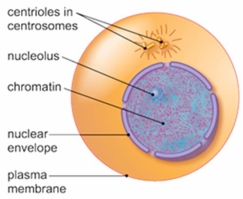
A) anaphase
B) interphase
C) metaphase
D) prophase
E) telophase

A) anaphase
B) interphase
C) metaphase
D) prophase
E) telophase

Unlock Deck
Unlock for access to all 78 flashcards in this deck.
Unlock Deck
k this deck
26
A group of cells is assayed for DNA content immediately following mitosis and is found to have an average of 8 picograms of DNA in the nucleus. Those cells would have ________ picograms at the end of the S phase and ________ picograms at the end of G2.
A) 8; 8
B) 8; 16
C) 16; 8
D) 16; 16
E) 12; 16
A) 8; 8
B) 8; 16
C) 16; 8
D) 16; 16
E) 12; 16

Unlock Deck
Unlock for access to all 78 flashcards in this deck.
Unlock Deck
k this deck
27
Rebecca found out that she has a mass of dividing cells called a tumor in her ovaries. She has had tests and is returning to the doctor. Which of the following would be the best news that Rebecca could receive from her doctor?
A) It is a benign tumor.
B) The cells are cancerous and are in situ.
C) It is a malignant tumor.
D) It is malignant ovarian cancer.
E) The tumor has metastasized and invaded neighboring tissue.
A) It is a benign tumor.
B) The cells are cancerous and are in situ.
C) It is a malignant tumor.
D) It is malignant ovarian cancer.
E) The tumor has metastasized and invaded neighboring tissue.

Unlock Deck
Unlock for access to all 78 flashcards in this deck.
Unlock Deck
k this deck
28
How do the daughter cells at the end of mitosis and cytokinesis compare to their parent cell when it was in G1 of the cell cycle?
A) The daughter cells have half the amount of cytoplasm and half the amount of DNA.
B) The daughter cells have half the number of chromosomes and half the amount of DNA.
C) The daughter cells have the same number of chromosomes and half the amount of DNA.
D) The daughter cells have the same number of chromosomes and the same amount of DNA.
E) The daughter cells have the same number of chromosomes and twice the amount of DNA.
A) The daughter cells have half the amount of cytoplasm and half the amount of DNA.
B) The daughter cells have half the number of chromosomes and half the amount of DNA.
C) The daughter cells have the same number of chromosomes and half the amount of DNA.
D) The daughter cells have the same number of chromosomes and the same amount of DNA.
E) The daughter cells have the same number of chromosomes and twice the amount of DNA.

Unlock Deck
Unlock for access to all 78 flashcards in this deck.
Unlock Deck
k this deck
29
What would occur in a cell if the production of cyclins halted during the cell cycle?
A) DNA would not be replicated in the S phase.
B) Organelles would not be duplicated in G1.
C) The cell would not complete cytokinesis.
D) The cell would enter the G0 phase.
E) The cell would remain in the G2 phase and would not enter into mitosis.
A) DNA would not be replicated in the S phase.
B) Organelles would not be duplicated in G1.
C) The cell would not complete cytokinesis.
D) The cell would enter the G0 phase.
E) The cell would remain in the G2 phase and would not enter into mitosis.

Unlock Deck
Unlock for access to all 78 flashcards in this deck.
Unlock Deck
k this deck
30
Cancer is a disorder in which some cells have lost the ability to control their
A) size.
B) spindle fibers.
C) rate of cell division.
D) surface area.
E) volume.
A) size.
B) spindle fibers.
C) rate of cell division.
D) surface area.
E) volume.

Unlock Deck
Unlock for access to all 78 flashcards in this deck.
Unlock Deck
k this deck
31
The term metastasis refers to the fact that cancer cells tend to
A) destroy.
B) divide.
C) decline.
D) shrink.
E) spread.
A) destroy.
B) divide.
C) decline.
D) shrink.
E) spread.

Unlock Deck
Unlock for access to all 78 flashcards in this deck.
Unlock Deck
k this deck
32
Cells grown in a petri dish tend to divide until they form a thin layer covering the bottom of the dish. If cells are removed from the middle of the dish, the cells bordering the open space will begin dividing until they have filled the empty space. What does this experiment show?
A) When cells come into contact with other cells, they stop growing.
B) The controls on cell growth and division can be turned on and off.
C) Cell division can be regulated by factors outside of the cell.
D) Cells continue to grow as long as there is adequate space.
E) All answers are valid and correct.
A) When cells come into contact with other cells, they stop growing.
B) The controls on cell growth and division can be turned on and off.
C) Cell division can be regulated by factors outside of the cell.
D) Cells continue to grow as long as there is adequate space.
E) All answers are valid and correct.

Unlock Deck
Unlock for access to all 78 flashcards in this deck.
Unlock Deck
k this deck
33
Some of the drugs used in chemotherapy work by
A) increasing telomeres.
B) preventing spindle formation.
C) producing kinases.
D) inhibiting cytokinesis.
E) causing cells to divide quickly.
A) increasing telomeres.
B) preventing spindle formation.
C) producing kinases.
D) inhibiting cytokinesis.
E) causing cells to divide quickly.

Unlock Deck
Unlock for access to all 78 flashcards in this deck.
Unlock Deck
k this deck
34
If there are 20 centromeres in a cell, how many chromosomes are there?
A) 10
B) 20
C) 30
D) 40
E) 80
A) 10
B) 20
C) 30
D) 40
E) 80

Unlock Deck
Unlock for access to all 78 flashcards in this deck.
Unlock Deck
k this deck
35
Which of the following is not a characteristic of cancer cells?
A) cells that have lost contact inhibition
B) cells with abnormal nuclei
C) cells that spend 90% of their lifetime in interphase
D) cells that lack differentiation
E) cells that have uncontrolled cell division
A) cells that have lost contact inhibition
B) cells with abnormal nuclei
C) cells that spend 90% of their lifetime in interphase
D) cells that lack differentiation
E) cells that have uncontrolled cell division

Unlock Deck
Unlock for access to all 78 flashcards in this deck.
Unlock Deck
k this deck
36
If a cell has 46 chromosomes at the beginning of mitosis, then at the end of anaphase there would be a total of
A) 23 chromatids.
B) 23 chromosomes.
C) 46 chromatids.
D) 46 chromosomes.
E) 92 chromosomes.
A) 23 chromatids.
B) 23 chromosomes.
C) 46 chromatids.
D) 46 chromosomes.
E) 92 chromosomes.

Unlock Deck
Unlock for access to all 78 flashcards in this deck.
Unlock Deck
k this deck
37
Apoptosis
A) is a process that repairs damaged DNA.
B) occurs as telomeres increase in length.
C) can be used to remove damaged or malfunctioning cells.
D) increases the number of somatic cells.
E) increases the number of gamete cells.
A) is a process that repairs damaged DNA.
B) occurs as telomeres increase in length.
C) can be used to remove damaged or malfunctioning cells.
D) increases the number of somatic cells.
E) increases the number of gamete cells.

Unlock Deck
Unlock for access to all 78 flashcards in this deck.
Unlock Deck
k this deck
38
Cancer occurs when
A) cells are unable to divide because of a mutation.
B) faulty spindle fibers are unable to pull chromatids apart.
C) apoptosis occurs.
D) both uncontrolled cell division and stimulation of apoptosis occurs.
E) the regulation of the cell cycle is lost and uncontrolled cell division occurs.
A) cells are unable to divide because of a mutation.
B) faulty spindle fibers are unable to pull chromatids apart.
C) apoptosis occurs.
D) both uncontrolled cell division and stimulation of apoptosis occurs.
E) the regulation of the cell cycle is lost and uncontrolled cell division occurs.

Unlock Deck
Unlock for access to all 78 flashcards in this deck.
Unlock Deck
k this deck
39
Susan went to an oncologist because some cancerous cells had been detected within her breast tissue. Which of the following is not a warning signal for cancer?
A) The cells in the breast tissue lacked differentiation.
B) Some cells in the tissue had failed to acquire the specialized structure that the cell should have.
C) Some cells had abnormally large nuclei.
D) The cells had an abnormal number of chromosomes.
E) Some cells were found to be in interphase.
A) The cells in the breast tissue lacked differentiation.
B) Some cells in the tissue had failed to acquire the specialized structure that the cell should have.
C) Some cells had abnormally large nuclei.
D) The cells had an abnormal number of chromosomes.
E) Some cells were found to be in interphase.

Unlock Deck
Unlock for access to all 78 flashcards in this deck.
Unlock Deck
k this deck
40
Cytokinesis usually, but not always, follows mitosis. If a cell undergoes mitosis and not cytokinesis, this would result in
A) a cell with a single large nucleus.
B) a cell with two or more nuclei.
C) cells with abnormally small nuclei.
D) feedback responses that prevent mitosis.
E) death of the cell line.
A) a cell with a single large nucleus.
B) a cell with two or more nuclei.
C) cells with abnormally small nuclei.
D) feedback responses that prevent mitosis.
E) death of the cell line.

Unlock Deck
Unlock for access to all 78 flashcards in this deck.
Unlock Deck
k this deck
41
A woman inherits a mutant BRCA1 allele from her mother. She has an increased risk of developing breast cancer because
A) every cell in the woman's body has a copy of the mutant BRCA1 allele.
B) she still has one normal allele of the BRCA1 gene that can make up for the loss of function in the mutant allele.
C) some of the cells in her body are already cancerous, meaning that no further mutations are needed for a tumor to form.
D) the normal BRCA1 allele is more likely to mutate than in an individual without a mutant BRCA1 allele.
E) a mutation in her normal BRCA1 allele may lead to cancer, whereas a normal individual would have to acquire two mutations one in each allele) to develop cancer.
A) every cell in the woman's body has a copy of the mutant BRCA1 allele.
B) she still has one normal allele of the BRCA1 gene that can make up for the loss of function in the mutant allele.
C) some of the cells in her body are already cancerous, meaning that no further mutations are needed for a tumor to form.
D) the normal BRCA1 allele is more likely to mutate than in an individual without a mutant BRCA1 allele.
E) a mutation in her normal BRCA1 allele may lead to cancer, whereas a normal individual would have to acquire two mutations one in each allele) to develop cancer.

Unlock Deck
Unlock for access to all 78 flashcards in this deck.
Unlock Deck
k this deck
42
Embryonic cells and cancer cells are similar because
A) DNA polymerase is inactive.
B) telomerase is active.
C) telomerase is inactive.
D) RNA polymerase is inactive.
E) proto-oncogenes are inactive.
A) DNA polymerase is inactive.
B) telomerase is active.
C) telomerase is inactive.
D) RNA polymerase is inactive.
E) proto-oncogenes are inactive.

Unlock Deck
Unlock for access to all 78 flashcards in this deck.
Unlock Deck
k this deck
43
A proto-oncogene differs from a tumor suppressor gene because a proto-oncogene
A) may cause cancer if mutated, whereas a tumor suppressor gene cannot.
B) stimulates mitosis in a normal cell, whereas a tumor suppressor gene inhibits mitosis.
C) only activates enzymes in a cell that allows metastasis.
D) inhibits the cell cycle, whereas a tumor suppressor accelerates the cell cycle.
E) promotes meiosis, whereas a tumor suppressor gene promotes mitosis.
A) may cause cancer if mutated, whereas a tumor suppressor gene cannot.
B) stimulates mitosis in a normal cell, whereas a tumor suppressor gene inhibits mitosis.
C) only activates enzymes in a cell that allows metastasis.
D) inhibits the cell cycle, whereas a tumor suppressor accelerates the cell cycle.
E) promotes meiosis, whereas a tumor suppressor gene promotes mitosis.

Unlock Deck
Unlock for access to all 78 flashcards in this deck.
Unlock Deck
k this deck
44
Inheritance of mutant forms of some genes may lead to a predisposition to develop cancer. Which of the genes listed below has not been linked to hereditary forms of cancer?
A) BRCA1
B) RB
C) RET
D) RAS
E) DScam
A) BRCA1
B) RB
C) RET
D) RAS
E) DScam

Unlock Deck
Unlock for access to all 78 flashcards in this deck.
Unlock Deck
k this deck
45
The looping of DNA around histone proteins
A) produces the characteristic helix shape of the DNA.
B) allows the room for cellular machinery to reach all genes so they may be transcribed.
C) condenses a large amount of DNA so that it can fit into the cell.
D) prevents the DNA from becoming kinked and breaking.
E) occurs when the DNA is damaged and allows the cell to be destroyed through apoptosis.
A) produces the characteristic helix shape of the DNA.
B) allows the room for cellular machinery to reach all genes so they may be transcribed.
C) condenses a large amount of DNA so that it can fit into the cell.
D) prevents the DNA from becoming kinked and breaking.
E) occurs when the DNA is damaged and allows the cell to be destroyed through apoptosis.

Unlock Deck
Unlock for access to all 78 flashcards in this deck.
Unlock Deck
k this deck
46
Some multicellular organisms, like the hydra, use asexual reproduction to produce a bud that leads to a new organism. This means that they are using
A) binary fission to create new cells.
B) mitotic division to create new cells that become a new organism.
C) meiosis to create new cells that become a new organism.
D) mitotic division to create gametes that give rise to a new organism.
E) meiosis I only to give rise to new organisms.
A) binary fission to create new cells.
B) mitotic division to create new cells that become a new organism.
C) meiosis to create new cells that become a new organism.
D) mitotic division to create gametes that give rise to a new organism.
E) meiosis I only to give rise to new organisms.

Unlock Deck
Unlock for access to all 78 flashcards in this deck.
Unlock Deck
k this deck
47
Angiogenesis contributes to carcinogenesis because it
A) allows tumor cells to spread to other parts of the body.
B) causes blood vessels to grow into the tumor.
C) allows tumor cells to invade underlying tissues.
D) causes additional mutations to occur in tumor cells.
E) causes apoptosis in tumor cells.
A) allows tumor cells to spread to other parts of the body.
B) causes blood vessels to grow into the tumor.
C) allows tumor cells to invade underlying tissues.
D) causes additional mutations to occur in tumor cells.
E) causes apoptosis in tumor cells.

Unlock Deck
Unlock for access to all 78 flashcards in this deck.
Unlock Deck
k this deck
48
A positive genetic test for telomerase indicates that
A) RB is inactive.
B) a cell is undergoing apoptosis.
C) proto-oncogenes have not yet mutated.
D) a cell is probably cancerous.
E) tumor suppressors are active.
A) RB is inactive.
B) a cell is undergoing apoptosis.
C) proto-oncogenes have not yet mutated.
D) a cell is probably cancerous.
E) tumor suppressors are active.

Unlock Deck
Unlock for access to all 78 flashcards in this deck.
Unlock Deck
k this deck
49
Unicellular organisms undergo mitotic division to
A) repair damaged cells.
B) increase the size of the organism.
C) produce new organisms.
D) increase the genetic variability of the population.
E) produce gametes.
A) repair damaged cells.
B) increase the size of the organism.
C) produce new organisms.
D) increase the genetic variability of the population.
E) produce gametes.

Unlock Deck
Unlock for access to all 78 flashcards in this deck.
Unlock Deck
k this deck
50
Plant cells and animal cells differ in cytokinesis because
A) plant cells need to build a cell wall, while animal cells do not.
B) plant cells need to build a cell wall, while animal cells built the extra cellular matrix.
C) animal cells need to build a cell membrane, while plant cells do not.
D) animal cells are living, while plant cells are not.
E) plant cells divide by mitosis, while animal cells divide by meiosis.
A) plant cells need to build a cell wall, while animal cells do not.
B) plant cells need to build a cell wall, while animal cells built the extra cellular matrix.
C) animal cells need to build a cell membrane, while plant cells do not.
D) animal cells are living, while plant cells are not.
E) plant cells divide by mitosis, while animal cells divide by meiosis.

Unlock Deck
Unlock for access to all 78 flashcards in this deck.
Unlock Deck
k this deck
51
A tumor suppressor gene undergoes a mutation that causes it to lose its normal function. What would be the most likely result of this mutation?
A) The cell cycle halts and reverses back to the G0 stage.
B) The cell loses contact inhibition even when it is not surrounded by other cells.
C) The cell cycle accelerates.
D) The cell no longer responds to signals that cause it to stop dividing or undergo apoptosis.
E) The cell stops dividing permanently and will never re-enter the cell cycle.
A) The cell cycle halts and reverses back to the G0 stage.
B) The cell loses contact inhibition even when it is not surrounded by other cells.
C) The cell cycle accelerates.
D) The cell no longer responds to signals that cause it to stop dividing or undergo apoptosis.
E) The cell stops dividing permanently and will never re-enter the cell cycle.

Unlock Deck
Unlock for access to all 78 flashcards in this deck.
Unlock Deck
k this deck
52
The spindle serves two roles in mitotic cell division. These are to separate the
A) sister chromatids and to elongate the cell.
B) non-sister chromatids and then the homologous chromosomes.
C) sister chromatids and then the non-sister chromatids.
D) sister chromatids and then form the cleavage furrow.
E) homologous chromosomes and then form the cleavage furrow.
A) sister chromatids and to elongate the cell.
B) non-sister chromatids and then the homologous chromosomes.
C) sister chromatids and then the non-sister chromatids.
D) sister chromatids and then form the cleavage furrow.
E) homologous chromosomes and then form the cleavage furrow.

Unlock Deck
Unlock for access to all 78 flashcards in this deck.
Unlock Deck
k this deck
53
The mitotic spindle is composed of ________ and grows from the ________ toward the center of the cell.
A) microtubules; centrosome
B) asters; spindle equator
C) centrosomes; aster
D) microtubules; chromatid
E) microtubules; cleavage furrow
A) microtubules; centrosome
B) asters; spindle equator
C) centrosomes; aster
D) microtubules; chromatid
E) microtubules; cleavage furrow

Unlock Deck
Unlock for access to all 78 flashcards in this deck.
Unlock Deck
k this deck
54
A mutation that causes an increase in function in a tumor suppressor gene would not likely cause cancer because a tumor suppressor protein
A) normally promotes the cell cycle.
B) normally responds to growth factors.
C) activates a signal transduction pathway.
D) inactivates growth factors.
E) does not promote cell division.
A) normally promotes the cell cycle.
B) normally responds to growth factors.
C) activates a signal transduction pathway.
D) inactivates growth factors.
E) does not promote cell division.

Unlock Deck
Unlock for access to all 78 flashcards in this deck.
Unlock Deck
k this deck
55
Cells that do not receive the correct signals to move from G1 into S phase will enter G0 and therefore will
A) immediately move into the mitotic phase.
B) never be able to undergo mitosis.
C) be able to produce gametes through meiosis.
D) stay in an undifferentiated state and become stem cells.
E) not undergo mitotic division unless it later receives the go-ahead signal.
A) immediately move into the mitotic phase.
B) never be able to undergo mitosis.
C) be able to produce gametes through meiosis.
D) stay in an undifferentiated state and become stem cells.
E) not undergo mitotic division unless it later receives the go-ahead signal.

Unlock Deck
Unlock for access to all 78 flashcards in this deck.
Unlock Deck
k this deck
56
Cytokinesis in plants occurs as ________ and in animals as ________.
A) actin fibers pull the membrane inward until the two sides touch; the Golgi apparatus produces membrane-bound vesicles filled with materials to make the cell wall
B) the Golgi apparatus produces membrane-bound vesicles filled with materials to make the cell wall; actin fibers pull the membrane inward until the two sides touch
C) the centrosome produces membrane-bound vesicles filled with materials to make the cell wall; the Golgi apparatus produces actin fibers to pull the membrane inward until the two sides touch
D) actin fibers interact to make the cell wall; the cleavage furrow pulls the membrane inward until the two sides touch
E) the Golgi apparatus produces a cleavage furrow; actin fibers pull the membrane inward until the two sides touch
A) actin fibers pull the membrane inward until the two sides touch; the Golgi apparatus produces membrane-bound vesicles filled with materials to make the cell wall
B) the Golgi apparatus produces membrane-bound vesicles filled with materials to make the cell wall; actin fibers pull the membrane inward until the two sides touch
C) the centrosome produces membrane-bound vesicles filled with materials to make the cell wall; the Golgi apparatus produces actin fibers to pull the membrane inward until the two sides touch
D) actin fibers interact to make the cell wall; the cleavage furrow pulls the membrane inward until the two sides touch
E) the Golgi apparatus produces a cleavage furrow; actin fibers pull the membrane inward until the two sides touch

Unlock Deck
Unlock for access to all 78 flashcards in this deck.
Unlock Deck
k this deck
57
An oncogene is more likely to lead to cancer than a mutant tumor suppressor gene because
A) a gain of function mutation in an oncogene need only occur in one allele before it disrupts control of the cell cycle.
B) a loss of function mutation in an oncogene is sufficient to cause unregulated cell division.
C) the mutant oncogene may inactivate telomerase.
D) a gain of function mutation in a tumor suppressor gene can promote the cell cycle.
E) a gain of function mutation in an oncogene is more likely to cause the other allele to mutate.
A) a gain of function mutation in an oncogene need only occur in one allele before it disrupts control of the cell cycle.
B) a loss of function mutation in an oncogene is sufficient to cause unregulated cell division.
C) the mutant oncogene may inactivate telomerase.
D) a gain of function mutation in a tumor suppressor gene can promote the cell cycle.
E) a gain of function mutation in an oncogene is more likely to cause the other allele to mutate.

Unlock Deck
Unlock for access to all 78 flashcards in this deck.
Unlock Deck
k this deck
58
Which of the following is not a characteristic of cancer cells?
A) stimulate the growth of blood vessels
B) travel through the bloodstream to other parts of the body
C) exhibit contact inhibition
D) have abnormal chromosomes
E) produced by a mutation of a proto-oncogene
A) stimulate the growth of blood vessels
B) travel through the bloodstream to other parts of the body
C) exhibit contact inhibition
D) have abnormal chromosomes
E) produced by a mutation of a proto-oncogene

Unlock Deck
Unlock for access to all 78 flashcards in this deck.
Unlock Deck
k this deck
59
Multicellular organisms undergo mitotic cell division to
A) produce new organisms.
B) produce gametes.
C) increase the variability of the population.
D) increase the size of the organism.
E) facilitate sexual reproduction.
A) produce new organisms.
B) produce gametes.
C) increase the variability of the population.
D) increase the size of the organism.
E) facilitate sexual reproduction.

Unlock Deck
Unlock for access to all 78 flashcards in this deck.
Unlock Deck
k this deck
60
A translocation may lead to cancer if it
A) disrupts control of expression of genes that regulate the cell cycle.
B) deletes the telomere of the chromosome.
C) moves genes from one chromosome to another.
D) activates tumor suppressor genes.
E) affects both tumor suppressor and proto-oncogenes.
A) disrupts control of expression of genes that regulate the cell cycle.
B) deletes the telomere of the chromosome.
C) moves genes from one chromosome to another.
D) activates tumor suppressor genes.
E) affects both tumor suppressor and proto-oncogenes.

Unlock Deck
Unlock for access to all 78 flashcards in this deck.
Unlock Deck
k this deck
61
Stem cells that contain telomerase can be found in adults.

Unlock Deck
Unlock for access to all 78 flashcards in this deck.
Unlock Deck
k this deck
62
A protein that promotes apoptosis would be considered an)
A) oncogene.
B) proto-oncogene.
C) tumor suppressor.
D) mutant tumor suppressor.
E) signal transduction pathway protein.
A) oncogene.
B) proto-oncogene.
C) tumor suppressor.
D) mutant tumor suppressor.
E) signal transduction pathway protein.

Unlock Deck
Unlock for access to all 78 flashcards in this deck.
Unlock Deck
k this deck
63
If tumor cells have a faulty, nonfunctional proteinase, they will be unable to undergo which of the following processes?
A) mitosis
B) mutations
C) metastasis
D) apoptosis
E) angiogenesis
A) mitosis
B) mutations
C) metastasis
D) apoptosis
E) angiogenesis

Unlock Deck
Unlock for access to all 78 flashcards in this deck.
Unlock Deck
k this deck
64
What is the structure that holds together the two sister chromatids that form a chromosome?
A) centromere
B) nucleosome
C) histone
D) nucleus
E) chromatin
A) centromere
B) nucleosome
C) histone
D) nucleus
E) chromatin

Unlock Deck
Unlock for access to all 78 flashcards in this deck.
Unlock Deck
k this deck
65
Cancer will occur if one copy of a mutant tumor suppressor gene is inherited.

Unlock Deck
Unlock for access to all 78 flashcards in this deck.
Unlock Deck
k this deck
66
If a cell stops at the G1 checkpoint, this is most likely due to what problem?
A) There is DNA damage.
B) The DNA has not finished replicating.
C) The chromosomes are not aligned properly.
D) The cell is cancerous.
E) There is no problem. The cell normally stops at the G1 checkpoint.
A) There is DNA damage.
B) The DNA has not finished replicating.
C) The chromosomes are not aligned properly.
D) The cell is cancerous.
E) There is no problem. The cell normally stops at the G1 checkpoint.

Unlock Deck
Unlock for access to all 78 flashcards in this deck.
Unlock Deck
k this deck
67
What structure is formed by two sister chromatids being held together by a centromere?
A) chromosome
B) chromatin
C) histones
D) nucleosome
E) DNA
A) chromosome
B) chromatin
C) histones
D) nucleosome
E) DNA

Unlock Deck
Unlock for access to all 78 flashcards in this deck.
Unlock Deck
k this deck
68
Proto-oncogenes function by preventing cells from dividing uncontrollably.

Unlock Deck
Unlock for access to all 78 flashcards in this deck.
Unlock Deck
k this deck
69
During which stage of the cell cycle do the chromosomes duplicate?
A) interphase: S
B) interphase: G1
C) interphase: G2
D) prophase
E) telophase
A) interphase: S
B) interphase: G1
C) interphase: G2
D) prophase
E) telophase

Unlock Deck
Unlock for access to all 78 flashcards in this deck.
Unlock Deck
k this deck
70
Cancer cells have abnormal chromosomes because they express telomerase when they should not.

Unlock Deck
Unlock for access to all 78 flashcards in this deck.
Unlock Deck
k this deck
71
Which lifestyle choice is responsible for 90% of the cases of lung cancer among men?
A) smoking
B) using tanning beds
C) excessive alcohol consumption
D) drug use
E) using smokeless tobacco
A) smoking
B) using tanning beds
C) excessive alcohol consumption
D) drug use
E) using smokeless tobacco

Unlock Deck
Unlock for access to all 78 flashcards in this deck.
Unlock Deck
k this deck
72
The presence of which protein is required in order for chromatin to compact correctly within the nucleus?
A) histone
B) nucleosome
C) actin
D) chromatid
E) myosin
A) histone
B) nucleosome
C) actin
D) chromatid
E) myosin

Unlock Deck
Unlock for access to all 78 flashcards in this deck.
Unlock Deck
k this deck
73
Which cancer therapy can lead to side effects such as nausea and hair loss?
A) chemotherapy
B) surgery
C) hormonal therapy
D) drug therapy
E) All of these can lead to nausea and hair loss.
A) chemotherapy
B) surgery
C) hormonal therapy
D) drug therapy
E) All of these can lead to nausea and hair loss.

Unlock Deck
Unlock for access to all 78 flashcards in this deck.
Unlock Deck
k this deck
74
Losing weight can reduce an obese person's risk for cancer by up to 40%.

Unlock Deck
Unlock for access to all 78 flashcards in this deck.
Unlock Deck
k this deck
75
Translocations can lead to cancer if they disrupt the genes that regulate the cell cycle.

Unlock Deck
Unlock for access to all 78 flashcards in this deck.
Unlock Deck
k this deck
76
Which is not a correct association?
A) interphase - shortest stage of the cell cycle
B) S stage - DNA synthesis
C) M stage - mitosis and cytokinesis
D) G1 stage - cell grows in size and cell organelles increase in number
E) G2 stage - metabolic preparation for mitosis
A) interphase - shortest stage of the cell cycle
B) S stage - DNA synthesis
C) M stage - mitosis and cytokinesis
D) G1 stage - cell grows in size and cell organelles increase in number
E) G2 stage - metabolic preparation for mitosis

Unlock Deck
Unlock for access to all 78 flashcards in this deck.
Unlock Deck
k this deck
77
If cancer is discovered at an early stage, which treatment method is most often used?
A) surgery
B) radiation
C) chemotherapy
D) hormonal therapy
E) drug therapy
A) surgery
B) radiation
C) chemotherapy
D) hormonal therapy
E) drug therapy

Unlock Deck
Unlock for access to all 78 flashcards in this deck.
Unlock Deck
k this deck
78
When a portion of a chromosome breaks off and attaches to a different chromosome, this is called a
A) translocation.
B) telomerase.
C) apoptosis event.
D) suppressor event.
E) jumping gene.
A) translocation.
B) telomerase.
C) apoptosis event.
D) suppressor event.
E) jumping gene.

Unlock Deck
Unlock for access to all 78 flashcards in this deck.
Unlock Deck
k this deck



